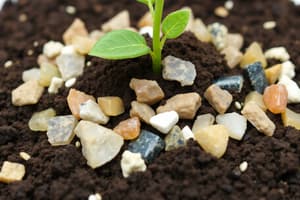Podcast
Questions and Answers
What is the primary function of clay minerals in soil?
What is the primary function of clay minerals in soil?
- Control soil pH levels
- Provide essential nutrients for plants
- Help maintain trace element nutrients
- Aid in water retention and soil structure (correct)
Which minerals form the backbone of nearly all soils?
Which minerals form the backbone of nearly all soils?
- Sulfide minerals
- Clay minerals
- Carbonate minerals
- Silicate minerals (correct)
What is the primary source of carbonate minerals found in soil?
What is the primary source of carbonate minerals found in soil?
- Living organisms
- Weathered rocks
- Groundwater
- Dissolved carbonates (correct)
Which type of minerals help maintain the availability of trace element nutrients within the soil ecosystem?
Which type of minerals help maintain the availability of trace element nutrients within the soil ecosystem?
What role do silicate minerals play in soil ecosystems?
What role do silicate minerals play in soil ecosystems?
Which of the following mineral types contributes significantly to cation exchange capacity (CEC) in soil?
Which of the following mineral types contributes significantly to cation exchange capacity (CEC) in soil?
Which mineral is the most common natural phosphate mineral present in soils?
Which mineral is the most common natural phosphate mineral present in soils?
What creates permanent negative charges in the soil matrix, aiding in ion exchange?
What creates permanent negative charges in the soil matrix, aiding in ion exchange?
Which mineral category contributes to essential properties like color, soil structure, and stability?
Which mineral category contributes to essential properties like color, soil structure, and stability?
What type of minerals develop from various geochemical reactions in soil, providing essential nutrients like sodium and calcium?
What type of minerals develop from various geochemical reactions in soil, providing essential nutrients like sodium and calcium?
Why do scientists categorize soils based on their specific mineral makeup?
Why do scientists categorize soils based on their specific mineral makeup?
What type of soil texture is characterized by varying proportions of sand, silt, and clay fractions?
What type of soil texture is characterized by varying proportions of sand, silt, and clay fractions?
Flashcards are hidden until you start studying
Study Notes
Unraveling Soil's Building Blocks: Mineral Components
Soil is more than just a mixture of dirt and organic matter; it's a fascinatingly complex system composed of four primary domains—minerals, water, air, and living organisms. Let's delve into soil's mineral foundation, which forms its backbone and provides essential nutrients for plants.
Types of minerals found in soil
Clay minerals: These tiny particles, typically less than two micrometers wide, originate from weathered rocks like shale, sandstone, and granite. Clay minerals contribute significantly to soil structure, water retention capability, and cation exchange capacity (CEC).
Silicate minerals: Formed through rock weathering, these compounds consist primarily of silicon, aluminum, iron, magnesium, calcium, and potassium. Silicates make up most of the earth's crust and form the basis for nearly all soils, providing key elements needed by plants.
Carbonate minerals: Derived principally from dissolved carbonates, such as limestone, dolomite, and calcite, carbonates play a crucial role in controlling soil pH levels. High concentrations can lead to alkaline conditions, while lower amounts result in acidic environments.
Sulfide minerals: Slightly soluble sulfides such as pyrite, galena, chalcopyrite, and sphalerite help maintain the availability of trace element nutrients like copper, zinc, molybdenum, chromium, selenium, and silver within the soil ecosystem. However, excessive quantities may cause environmental issues due to their potential toxicity and corrosiveness.
Phosphorus minerals: Phosphorus is a vital plant nutrient, with apatite being the most common natural phosphate mineral present in soils. Apatite releases phosphorous slowly over time, ensuring a constant supply to the root systems of growing crops.
Oxidized minerals: Iron oxides, manganese oxides, and aluminum hydroxides formed during chemical weathering processes create permanent negative charges in the soil matrix, facilitating ion exchange between roots, organic matter, and clay minerals. They also contribute to essential properties like color, soil structure, and stability.
Non-siliceous secondary minerals: Calcites, gypsums, and halite fall under this category. Secondary minerals develop from various geochemical reactions occurring in soil and represent additional sources of essential nutrients like sodium, calcium, and sulfur.
The collective presence of these mineral constituents makes every soil unique, leading scientists to categorize them according to their specific mineral makeup. Some well-known types include sandy loams, silt loams, sandy clay loams, and clayey textures characterized by varying proportions of sand, silt, and clay fractions. By understanding the fundamental characteristics of soil composition, we can better appreciate how they influence agricultural productivity, ecological health, and overall sustainability of our planet.
Studying That Suits You
Use AI to generate personalized quizzes and flashcards to suit your learning preferences.




